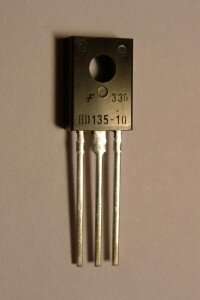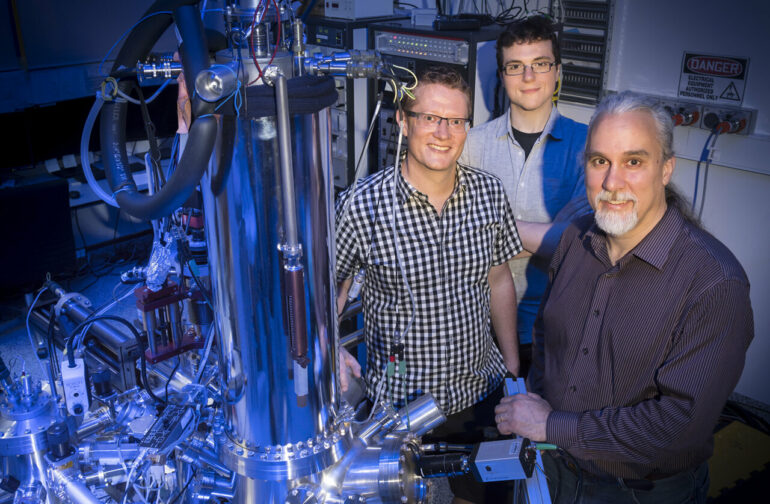Australian researchers have discovered that negative capacitance could lower the energy used in electronics and computing, which represents 8 percent of global electricity demand.
The researchers at four universities within the ARC Centre of Excellence in Future Low-Energy Electronics Technologies (FLEET) applied negative capacitance to make topological transistors switch at lower voltage, potentially reducing energy losses by a factor of 10 or more.
These very promising results are reported this week at the prestigious International Electron Devices Meeting in San Francisco. And while challenges remain to making a working benchtop device, the work is covered in a patent application.
What are transistors?
A transistor is an electronic switch. It has three terminals, or connections: a voltage applied to the gate terminal controls the current which can flow between other two terminals (called the source and drain terminals). In computer chips, the transistors can be “on” (i.e., current can flow) or “off” (current is blocked), representing the ones and zeroes that comprise binary logic operations.
Switching a transistor on and off requires wasting a tiny amount of electrical energy each time. But with the computer chips that make all of our electronic devices work contain millions or even billions of transistors, all switching billions of times a second (at gigahertz frequencies), this adds up to a lot of power being wasted as heat. “This is why your phone or laptop gets hot when you’re doing something that requires a lot of computations, such as processing a video,” says FLEET researcher Prof Michael Fuhrer (Monash).
All together, information communication and technology (ICT) consumes about 8 percent of global electricity supply –a staggering amount of electricity that is doubling every decade. According to the Decadal Plan for Semiconductors released in 2020, the imbalance between rising energy demands of ICT and available energy will ‘strongly limit’ future growth in computing.
Today’s computer chips are all made of silicon, a semiconductor. Semiconductors are insulators, materials that normally don’t conduct electricity. However, adding a bit of extra electrical charge to a semiconductor makes it conduct. This ability of silicon to switch on and off is the basis of the field-effect transistor (FET): the gate is connected by a capacitor to a slice of semiconductor running between source and drain terminals. A voltage on the gate charges that capacitor, and the extra charge on the semiconductor allows current to flow from source to drain.
Topological insulators
Instead of silicon, FLEET researchers are working with new kinds of quantum materials called topological insulators. These materials are insulating in their interiors, but conduct electricity on their boundaries: If they are three-dimensional then they conduct on their two-dimensional surfaces, and if they’re very thin (two-dimensional) they conduct along their one-dimensional edges.
Topological transistors
FLEET researchers found that an electric field can be used to switch a material from topological insulator (which conducts electricity along its edges) to a normal insulator (which doesn’t conduct at all). This allows a topological material to be used as a transistor, called a topological quantum field-effect transistor (TQFET).

While the millions of transistors inside modern electronics are only micrometres in size, their function mirrors that of the familiar three-legged transistors of 1970s radios and home electronics kits. © FLEET
Earlier this year, FLEET researchers discovered that the TQFET can switch at a lower voltage than a conventional FET, overcoming the so-called Boltzmann’s tyranny which sets the lower limit for the voltage required to switch a current at room temperature. FLEET researcher Muhammad Nadeem (University of Wollongong) says, “The low-voltage switching comes about due to an effect called spin-orbit coupling, which is stronger in heavier elements like bismuth. We found that bismuth-based TQFETs could switch at half the voltage, and one-quarter the energy, of similar-sized conventional FETs.”
Recently, the team found that they could lower the voltage, and the energy, much further by using a negative capacitor to connect the topological material to the gate terminal.
How can capacitance be negative?
A capacitor consists of two conductors separated by an insulator. It has a capacitance C, which expresses the amount of electrical charge Q on the metals when a voltage V is applied between them: C = Q/V. Normally this is a positive number. If it was negative, the capacitor would be inherently unstable, and would want to charge up without applying any external voltage.
But that’s exactly what a ferroelectric material does; it has a spontaneous polarization, which charges up its surfaces. So a ferroelectric material can be thought of as having a negative capacitance in a certain regime, though this regime is not normally accessible because it is unstable.
Salahuddin and Datta proposed in 2008 that a ferroelectric material could act as a negative capacitor in combination with the (positive) gate capacitance of an FET, to make a combined capacitor that is positive and stable. The net result is to amplify the electric field in a FET. They thought this might allow the FET to switch at lower voltage.
“Unfortunately, due to some very subtle effects in the way FETs work, the negative capacitance idea hasn’t proved very useful in conventional FETs,” says FLEET researcher A/Prof Dmitrie Culcer (UNSW). “The voltage lowering due to negative capacitance disappears in a well-designed FET, so it seems there’s not much to be gained using a negative capacitor.”
Negative capacitance boosts topological transistors
Recently, a team of FLEET researchers at Centre nodes Monash, RMIT, University of Wollongong and UNSW realized that this is not so for the TQFET. Adding a negative capacitance (a ferroelectric material) to make a negative capacitance TQFET (NC-TQFET) amplifies the electric field, which enables switching at much lower voltages and energies. “The TQFET uses electric field for switching, so can benefit directly from the electric field amplification that’s provided by the negative capacitance,” says FLEET researcher Prof Jared Cole (RMIT).
The team reported the results at the 2021 International Electron Devices Meeting in San Francisco this week. They calculate that a bismuth-based NC-TQFET using La-doped HfO2 as a ferroelectric (this ferroelectric material has already successfully been integrated with silicon) could achieve ten times lower switching energy than a state-of-the-art silicon FET. “There’s even more room for improvement,” said Fuhrer, “more advanced ferroelectrics with larger remnant polarizations could enable switching at even lower energies.”
However, many challenges remain to making a working NC-TQFET on the benchtop. Bismuth-based topological insulators with the right structure haven’t yet been made and tested experimentally, and integrating those materials with ferroelectric layers would pose a further challenge. Still, the NC-TQFET provides a clear blueprint for lowering the energy in future transistors.
The FLEET researchers have applied for a patent on the NC-TQFET concept, and FLEET is looking for opportunities to work with partners to develop the technology further. Topological transistors were last year added to the IEEE International Roadmap for Devices and Systems, the internationally agreed blueprint guiding exponential advances in semiconductor technology (mapped by the famous Moore’s Law) and includes plans for “More Moore,” “More than Moore” and beyond-CMOS technologies.
“Proposal for a Negative Capacitance Topological Quantum Field-Effect Transistor” was presented at the Institute of Electrical and Electronics Engineers’ International Electron Devices Meeting 16 December 2021.
More information:
Proposal for a Negative Capacitance Topological Quantum Field-Effect Transistor, Proceedings of the 2021 International Electron Devices Meeting, pp. 38.2.1–38.2.4 (2021).
Citation:
Negative capacitance in topological transistors could reduce computing’s unsustainable energy load (2021, December 16)



